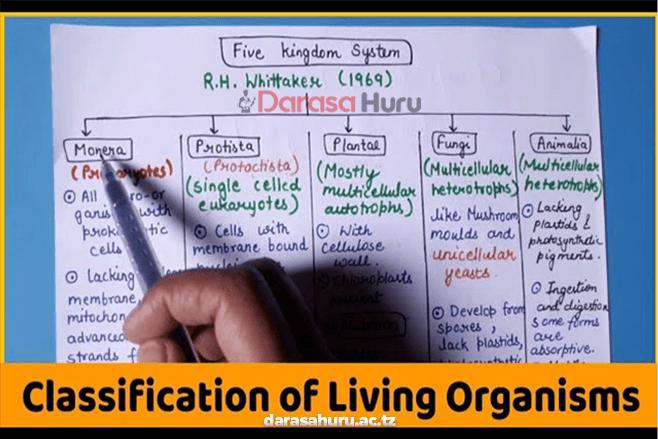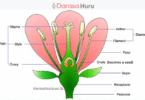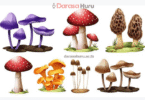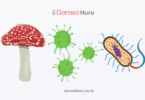Classification of Living Things
There are many species of living organisms in the world. These organisms are placed in groups based on their common or shared characteristics. Each group has its own features that make it distinct from others.
In this lesson, you will learn about viruses and five kingdoms of organisms, namely, Monera, Protoctista, Fungi, Plantae and Animalia. The competencies developed will enable you to distinguish members of these groups, understand their interrelationships and explore their importance to human beings and other organisms.
Concept of classification
Task 1
From reliable internet sources, library and other biology books, read about the meaning and importance of classification.
The process of grouping organisms according to their similarities and differences is called classification. Similar organisms are placed in the same group. The similarities can be in terms of their evolutionary relationship or the way they carry out life processes, such as feeding and reproduction.
The field of biology that deals with classifying organisms is called taxonomy. Organisms, such as snails, orange trees, crocodiles, birds, lions, and baobab trees belong to different groups.
Activity 1: Grouping living things according to their similarities and differences
Materials
A variety of small plants, insects, and other animals, notebook, and a pen or pencil
Procedure
1. Walk around the school compound and collect a variety of plants, insects, and other small animals.
2. Observe and group the collected organisms according to their similarities and differences.
3. Write the similarities and differences among the grouped organisms.
Caution
(a) Avoid collecting dangerous organisms, such as wasps, scorpions, and snake; and poisonous plants, such as milkweed and oleander.
(b) Avoid collecting weak or injured specimens as they will lead to incorrect observations.
Question
1. What did you learn from the activity?
2. Why do you think it is important to classify organisms?

The importance of classification
Classification is important in the study of living things because of the following reasons.
(a) There are millions of species of living things in the world. Grouping them makes it easier to study and identify them, because the members of the group have many characteristics in common.
(b) It makes communication among biologists in the world easier.
(c) It enables scientists to predict characteristics of an organism based on the characteristics of a group it belongs to. When we know the characteristics of a group then we can predict the characteristics of an organism in that group. For example, both an eagle and a chicken are birds. If we know the structure of the heart of a chicken, we can predict the structure of the heart of an eagle even if we have not seen it.
(d) It helps to understand how organisms are related in terms of their evolutionary history.
Classification systems
There are two main types of biological classification systems, namely artificial and natural classification systems.
Task 2
Read from reliable online sources, library and other biology books the information about artificial and natural classification systems.
Artificial system of classification
Artificial classification system groups organisms according to a few observable features, for example, the presence of legs or wings. Based on this, bees, birds, and bats would be grouped together because they have wings.
Snakes, earthworms, and snails would also be grouped together because they do not have legs. Artificial classification system also involves the use of some other characteristics, such as size, how organisms move, where they live, or what they eat.
In the third century BC, Aristotle (a Greek philosopher) used artificial classification system to classify plants. He grouped them according to their shape, size, and their usefulness or unusefulness to humans.
Activity 2
Classifying living things using artificial system of classification
Materials
A variety of living things or charts that show pictures of a bird, bat, bee, snake, snail, an earthworm, notebook and pen or a pencil
Procedure
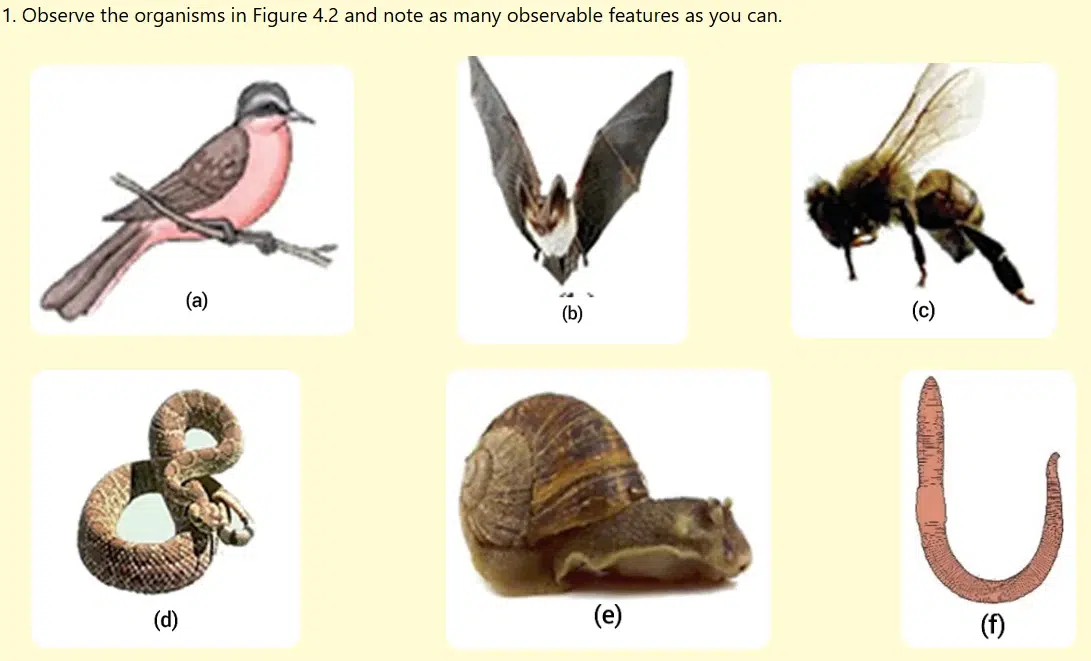
2. Classify the organisms in Figure 4.2 based on the following features:
(a) How big or small their size is
(b) How they move
(c) Where they live
3. How many organisms did you get in each of the categories in procedure 2?

Advantages of artificial system of classification
(a) It is based on simple and easily observable features. Artificial classification is therefore straightforward and easy to use.
(b) It is simple to identify and classify organisms since newly discovered organisms with just a few known features can be easily fitted in.
(c) It is stable because it does not change with time or new discoveries.
(d) It is less expensive because it uses few observable features to group the organisms.
(e) It does not require special classification techniques or highly skilled personnel.
Disadvantages of artificial system of classification
(a) Some organisms that are unrelated in their internal structure such as bats and birds can be grouped together because of the resemblances of their few external features.
(b) Similar organisms may be placed in different groups because of the use of only few observable features, for example, bats and rats can be grouped in different groups.
(c) It provides only limited information about each member. For example, organisms, such as bacteria and some fungi are grouped as micro-organisms because they are microscopic. This classification ignores other features, such as modes of feeding, reproduction, and cell structure.
(d) It does not allow the prediction of information; hence limits more advancement in taxonomy.
(e) It is less accurate because it uses only few observable characteristics, such as mode of feeding, habitat, locomotion, or presence of wings.
Natural system of classification
In the natural system of classification, organisms are grouped based on many features in common, particularly those related to evolutionary relationships. In this system, characters that show homology or similarity of origin must be distinguished from those showing analogy or similarity of use.
For example, the arms of man, forelimbs of whales, and wings of birds and bats are homologous structures. In contrast, the wings of birds and wings of insects perform similar functions but they are different origins hence, they are analogous. Natural classification system uses homologous characters.
Advantages of natural system of classification
(a) It allows organisms which are genetically and evolutionally related to be grouped together.
(b) It is more accurate, since it involves scientific research to gather enough information before the actual placement of an organism into a particular group is decided.
(c) It enables placing of newly discovered organisms into correct groups they belong.
(d) It allows addition of new features when they are discovered.
Disadvantages of natural system of classification
(a) It is very expensive since it involves experiments, researches, and high level of classification skills.
(b) It is tedious and time consuming since it uses many features in grouping organisms.
(c) It is not stable because it can change any time due to discovery of new features or information. Table 4.1 shows the differences between artificial and natural systems of classification.
Differences between artificial and natural system of classification
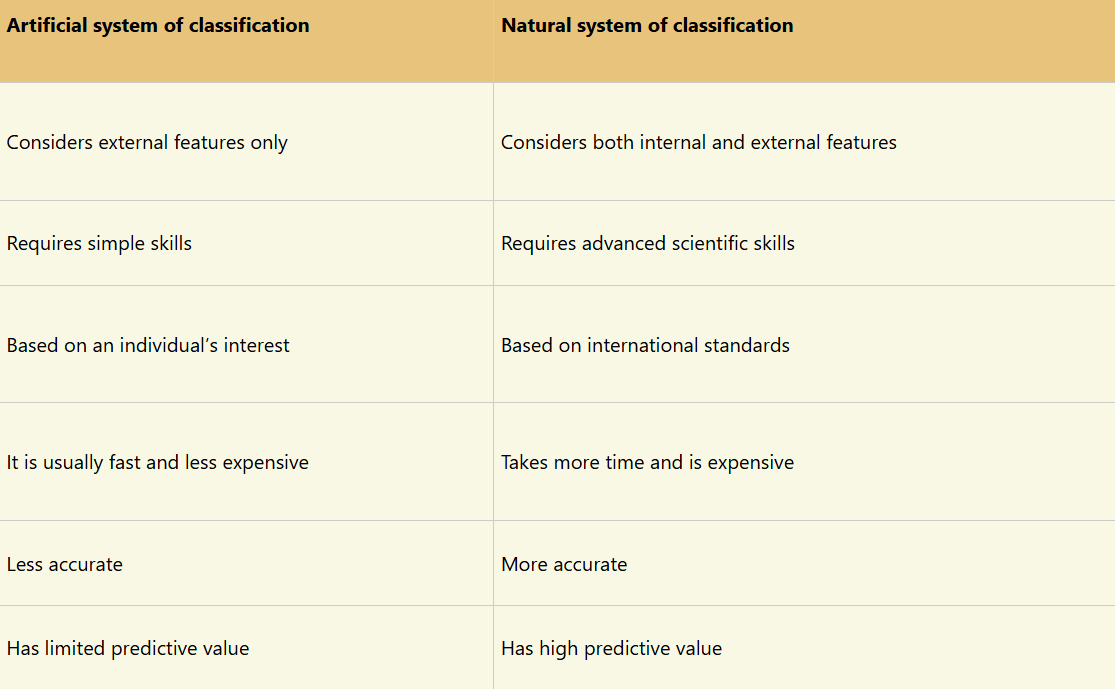
Activity 3
Classifying organisms based on artificial and natural system of classification
Materials
A variety of living things or charts showing pictures of organisms
Procedure
1. Observe the external features of organisms and note as many features as you can.
2. (a) Group the organisms based on artificial system of classification.
(b) Group the organisms based on natural system of classification.
Question
What are the main features used to place organisms into procedures number 2 (a) and (b)?

Major groups of living things
Task 3
Search from library and reliable internet sources the information on the major groups of living things and ranks of classification.
The following are the five major groups of living things that constitute the five kingdoms.
(a) Kingdom Monera, example, bacteria.
(b) Kingdom Protoctista, examples, amoeba, Plasmodium sp., and Euglena sp.
(c) Kingdom Fungi, examples, mushroom and yeast.
(d) Kingdom Plantae, examples, maize, bean, and banana plants.
(e) Kingdom Animalia, examples, human beings, dogs, and rats.
However, viruses have not been included in these five kingdoms because they possess features of both living and non-living things. Examples of viruses include Corona virus, Ebola virus, and HIV.
Ranks of classification
In classification of living things, there are seven main ranks or taxonomic units which are arranged hierarchically in a descending order from the highest to the lowest rank. Each unit is called a taxon (plural is taxa).
The main taxa are Kingdom, Phylum or Division, Class, Order, Family, Genus, and Species. The highest rank is Kingdom and the lowest is Species. Hierarchical arrangement of the taxonomic units or ranks is referred to taxonomic hierarchy.
Kingdom Animalia is subdivided into phyla (singular is phylum) while kingdom Plantae is subdivided into divisions. The phyla or divisions are further subdivided into classes. Each class is subdivided into orders. An order is subdivided into families and families are subdivided into genera (singular is genus). A genus is subdivided into species. A species is a group of closely related organisms that can interbreed freely under natural conditions and produce fertile offspring.
The flow chart in Figure 4.3 shows how kingdom Plantae and kingdom Animalia are subdivided.

Kingdoms contain different varieties of organisms. At kingdom level, organisms share few features in common. As you move down the ranks, each subsequent unit has fewer organisms and the members of each unit have many features in common.
At the species level, organisms share many features. Members of the same species can interbreed to produce fertile offspring, but organisms from different species do not interbreed. If they interbreed, they do not produce fertile offspring.
This is because of differences in genetic make-up, behaviour, and morphological features, such as structure of sexual organs. However, there are a few exceptions to this rule. For example, a horse and a donkey can interbreed to produce a mule.
Mules are usually but not always infertile. Dogs and wolves can interbreed to produce fertile offspring. In Table 4.2, a few common organisms have been classified from kingdom to species level.
Classification of some common organisms
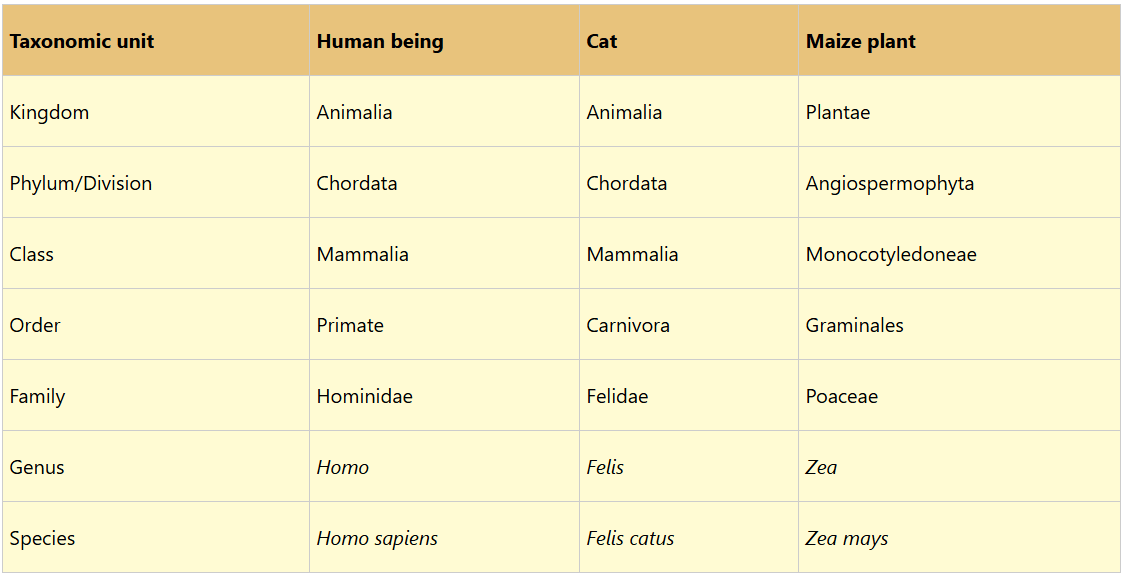
Note that the names of higher ranks (above species) always start with a capital letter. For example, the human being is in kingdom Animalia, phylum Chordata, class Mammalia, order Primate, family Hominidae, genus Homo, and species Homo sapiens.
Binomial nomenclature
Task 4
Search from library and reliable internet sources the information about naming of organisms.
Binomial nomenclature is a scientific system of naming organisms using a two-part name. The first part of the name represents the genus. It is also called the generic name. The second part of the name represents the specific epithet. The two parts form the name of a species or scientific name. This system was first introduced by Carl Linnaeus, who is also referred to as the father of classification.
As an example, the scientific name of a human being is Homo sapiens. ‘Homo’ is the generic name and ‘sapiens’ is the specific epithet. Scientific names of some other common organisms are shown in Table 4.3.
Rules of binomial nomenclature
The following rules are observed when writing scientific names.
(a) All scientific names must be written in Latin language or if is in a different language, the name must be Latinised.
(b) The name should have two parts; the first part represents the genus and the second part represents the specific epithet.
(c) The generic name is written before the specific epithet.
(d) The generic name must start with a capital letter and specific epithet begins with a small letter.
(e) In published documents, such as books, scientific names should be written in italics, for example Zea mays and Homo sapiens. When handwritten, the names must be underlined separately for example, Zea mays and Homo sapiens. Examples of how the scientific names of some common organisms are written in documents is shown in the table below:-
Scientific names of common organisms
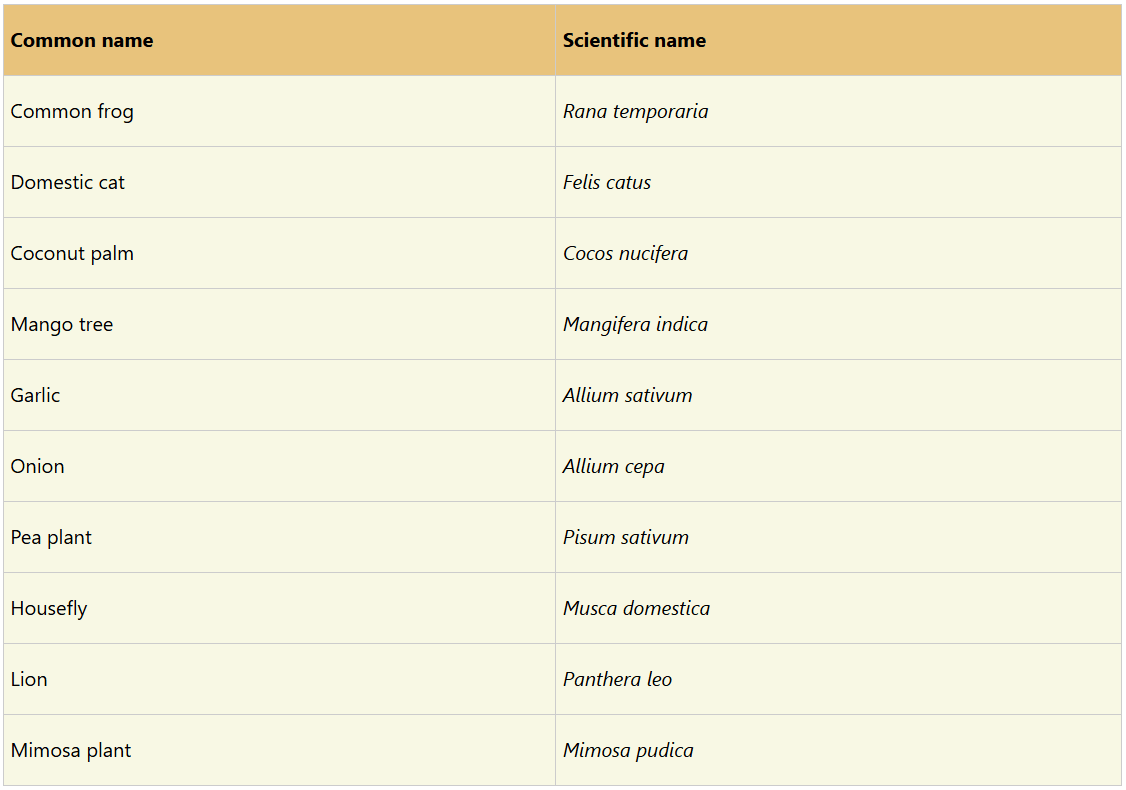
Chapter summary
1. Classification is the grouping of organisms based on their similarities and differences.
2. Classification is important because:
(a) It makes it easier to identify and study the millions of organisms in the world.
(b) Each organism (species) is referred to by the same name all over the world.
(c) It is easier to study organisms when they are in groups.
(d) It enables scientists to make predictions of information.
3. There are two main system of classification systems:
(a) Artificial system of classification is based on few observable features of organisms.
(b) Natural system of classification is based on many features in common particularly those related to evolutionary relationship.
4. In natural system of classification, organisms are divided into kingdoms, phyla or divisions, classes, orders, families, genera, and species. These units are called taxa (singular is taxon).
5. The members of a species are the most closely related. They can interbreed freely under natural conditions to produce fertile offspring.
6. Currently, five kingdoms are recognised, namely Monera, Protoctista, Fungi, Plantae, and Animalia.
7. Binomial nomenclature is the system of giving scientific names to organisms. A scientific name has two parts:
(a) The first part is the generic name.
(b) The second part is the specific epithet.
Revision Exercise
1. Match each item from Column A with its corresponding item in Column B
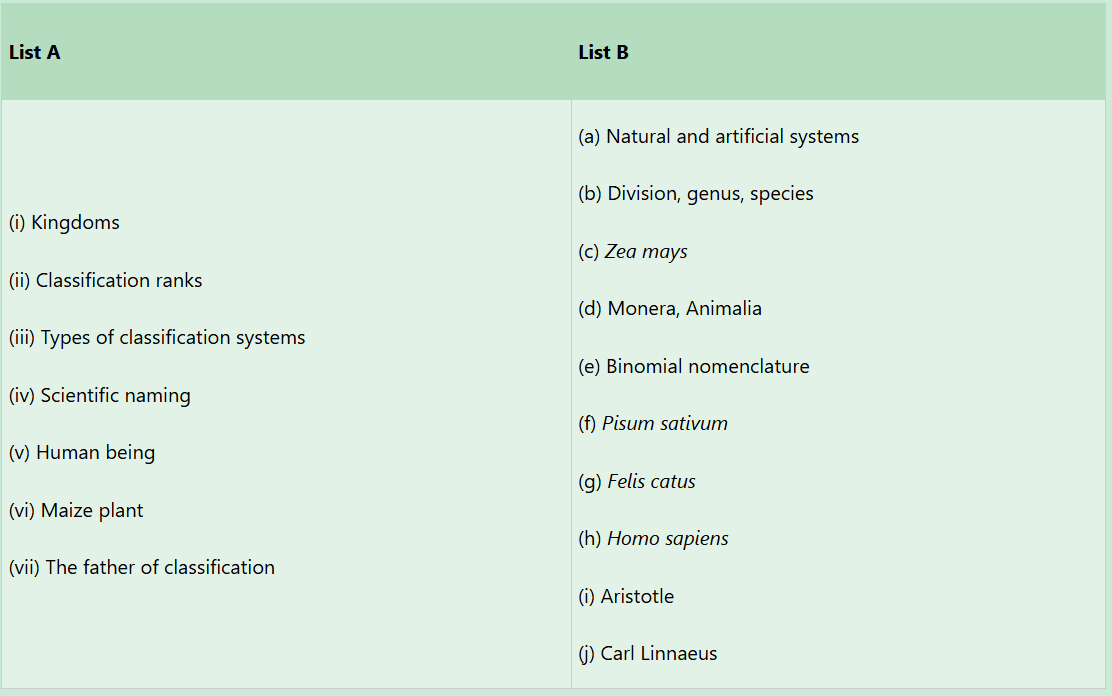
2. Write TRUE for a correct statement and FALSE for an incorrect statement in the space provided.
(a) Artificial system of classification is based on few observable features. __________
(b) The process of sorting living things into groups is called classification. __________
(c) Organisms of the same specie exhibit a low degree of similarity. _____
(d) The lowest rank in classification is the genus. __________
(e) Classification is based on similarities and differences among organisms. ______
3. Differentiate:
(a) Classification from taxonomy.
(b) Natural from artificial systems of classification.
4. Explain the concept of the biological species.
5. How would you apply the concept of classification in a real-world context?
6. Starting from the highest rank, outline the hierarchical ranks of classification in biology.
7. Explain why a chicken and a duck cannot interbreed even if they are kept in the same coop.
8. In a biology class, your fellow students classified pigeon and butterfly in the same group based on the presence of wings. Explain the shortcomings of their classification.
9. Diana wrote the scientific name of human beings as homosapiens. Explain why she was wrong.

